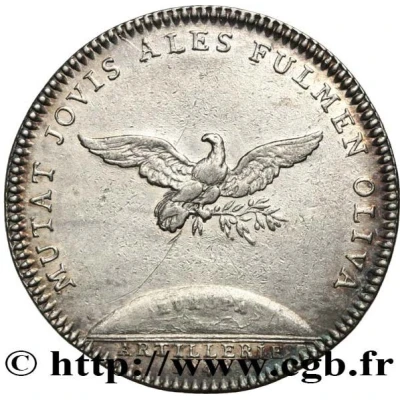Reverse
Eagle spread in the air, carrying an olive branch in its claws. Below, a part of a globe with the inscription: EUROPA.
Script: Latin
Lettering: MUTAT JOVIS ALES FULMEN OLIVA ; À L'EXERGUE : ARTILLERIE.1749.
Edge
Reeded
Comment
Before Louvois, the Artillery was entrusted to civilian contractors who provided men and equipment for a given price for each piece in battery. It was under the authority of a Grand Master of Artillery, an office created under Charles VII, which belonged to Sully from 1599 to 1610 or to the Duke of La Meilleraye under Richelieu. With Louvois, the Artillery became an integral part of the army and was protected by the regiment of the king's fusiliers. Ranks in the Artillery were more accessible to commoners than in other regiments, and advancement was given on merit and talent. Until the 18th century, the equipment left much to be desired with different calibers, different carriages and different wheels. The standardization and modernity of the Artillery owes much to J.-B. de Gribeauval, general inspector of the ARTILLERY since 1776. At the end of the 18th century, the French Artillery was the first in Europe and this superiority explained the victories of the Revolution.
This is an automatic translation. The original text is:
Avant Louvois, l'Artillerie était confiée à des entrepreneurs civils qui fournissaient pour un prix donné les hommes et le matériel par pièce en batterie. Elle relevait d'un grand maître de l'Artillerie, charge créée sous Charles VII, qui appartint à Sully de 1599 à 1610 ou au duc de la Meilleraye sous Richelieu. Avec Louvois, l'Artillerie devient partie intégrante de l'armée et elle est protégée par le régiment des fusiliers du roi. Les grades dans l'Artillerie étaient plus accessibles aux roturiers que dans les autres régiments, l'avancement y était donné aux mérites et aux talents. Jusqu'au XVIIIe siècle, le matériel laisse beaucoup à désirer avec différents calibres, différents affûts et différentes roues. L'uniformisation et la modernité de l'Artillerie devra beaucoup à J.-B. de Gribeauval, inspecteur général de l'ARTILLERIE dès 1776. À la fin du XVIIIe siècle, l'Artillerie française sera la première en Europe et cette supériorité expliquera les victoires de la Révolution.






